2019年考研政治经典复习资料(彩版)
2019年考研政治复习资料3556
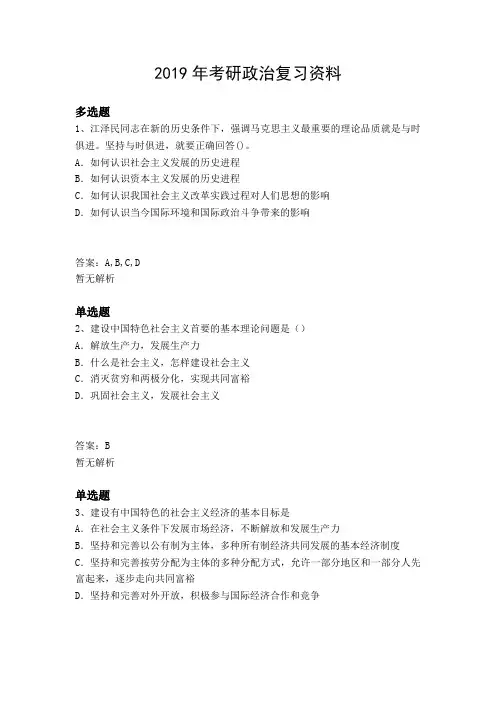
2019年考研政治复习资料多选题1、江泽民同志在新的历史条件下,强调马克思主义最重要的理论品质就是与时俱进。
坚持与时俱进,就要正确回答()。
A.如何认识社会主义发展的历史进程B.如何认识资本主义发展的历史进程C.如何认识我国社会主义改革实践过程对人们思想的影响D.如何认识当今国际环境和国际政治斗争带来的影响答案:A,B,C,D暂无解析单选题2、建设中国特色社会主义首要的基本理论问题是()A.解放生产力,发展生产力B.什么是社会主义,怎样建设社会主义C.消灭贫穷和两极分化,实现共同富裕D.巩固社会主义,发展社会主义答案:B暂无解析单选题3、建设有中国特色的社会主义经济的基本目标是A.在社会主义条件下发展市场经济,不断解放和发展生产力B.坚持和完善以公有制为主体,多种所有制经济共同发展的基本经济制度C.坚持和完善按劳分配为主体的多种分配方式,允许一部分地区和一部分人先富起来,逐步走向共同富裕D.坚持和完善对外开放,积极参与国际经济合作和竞争答案:A[解析] 做此题时考生要注意基本目标和基本政策是有直接联系的,基本目标是纲,基本政策是为实现基本目标而制订的。
这个题的备选BCD三项分别为实现经济、政治、文化三大基本目标的基本政策之内容,有些也很有干扰性,如C。
还要注意的是,建设有中国特色社会主义的经济、政治、文化的基本目标和基本政策,有机统一,不可分割,构成了党在社会主义初级阶段的基本纲领。
基本纲领的内容与基本路线易混淆,可参见《2006年政治理论辅导讲稿(汪云生等主编,当代世界出版社)》P410~413。
多选题4、邓小平理论形成和发展的社会历史条件是:A.时代主题从战争与革命转变到了和平与发展B.我国社会主义建设胜利与挫折的历史经验C.其他社会主义国家兴衰成败的历史经验D.我国改革开放和社会主义现代化建设的实践经验答案:A,B,C,D暂无解析多选题5、中国共产党第十七次全国代表大会上提出了党要始终站在时代前列带领人民不断开创事业发展新局面以改革精神全面推进党的建设新的伟大工程。
2019年考研政治必备
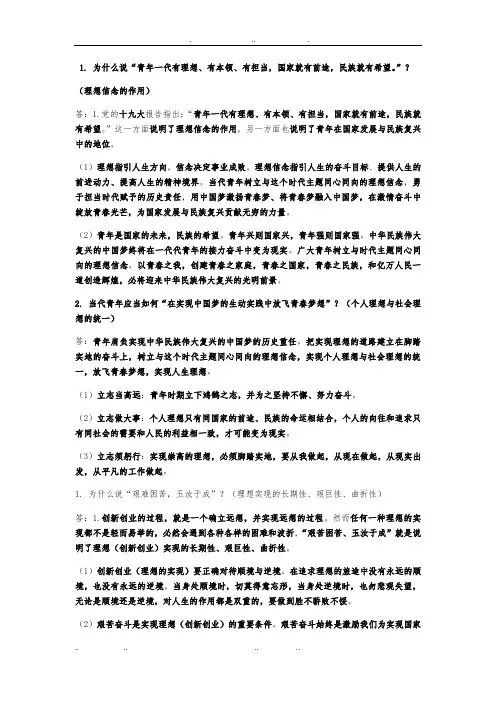
1. 为什么说“青年一代有理想、有本领、有担当,国家就有前途,民族就有希望。
”?(理想信念的作用)答:1.党的十九大报告指出:“青年一代有理想、有本领、有担当,国家就有前途,民族就有希望。
”这一方面说明了理想信念的作用,另一方面也说明了青年在国家发展与民族复兴中的地位。
(1)理想指引人生方向,信念决定事业成败。
理想信念指引人生的奋斗目标、提供人生的前进动力、提高人生的精神境界。
当代青年树立与这个时代主题同心同向的理想信念,勇于担当时代赋予的历史责任,用中国梦激扬青春梦、将青春梦融入中国梦,在激情奋斗中绽放青春光芒,为国家发展与民族复兴贡献无穷的力量。
(2)青年是国家的未来,民族的希望。
青年兴则国家兴,青年强则国家强。
中华民族伟大复兴的中国梦终将在一代代青年的接力奋斗中变为现实。
广大青年树立与时代主题同心同向的理想信念,以青春之我,创建青春之家庭,青春之国家,青春之民族,和亿万人民一道创造辉煌,必将迎来中华民族伟大复兴的光明前景。
2. 当代青年应当如何“在实现中国梦的生动实践中放飞青春梦想”?(个人理想与社会理想的统一)答:青年肩负实现中华民族伟大复兴的中国梦的历史重任,把实现理想的道路建立在脚踏实地的奋斗上,树立与这个时代主题同心同向的理想信念,实现个人理想与社会理想的统一,放飞青春梦想,实现人生理想。
(1)立志当高远:青年时期立下鸿鹄之志,并为之坚持不懈、努力奋斗。
(2)立志做大事:个人理想只有同国家的前途、民族的命运相结合,个人的向往和追求只有同社会的需要和人民的利益相一致,才可能变为现实。
(3)立志须躬行:实现崇高的理想,必须脚踏实地,要从我做起,从现在做起,从现实出发,从平凡的工作做起。
1. 为什么说“艰难困苦,玉汝于成”?(理想实现的长期性、艰巨性、曲折性)答:1.创新创业的过程,就是一个确立远想,并实现远想的过程。
然而任何一种理想的实现都不是轻而易举的,必然会遇到各种各样的困难和波折,“艰苦困苦、玉汝于成”就是说明了理想(创新创业)实现的长期性、艰巨性、曲折性。
2019版考研政治复习考点
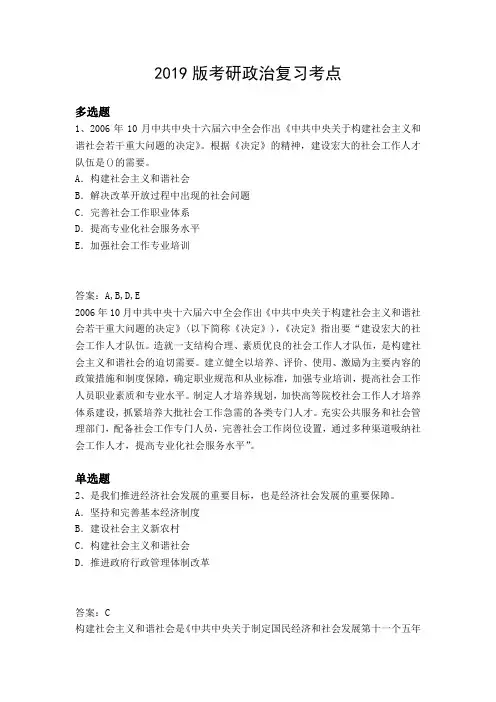
2019版考研政治复习考点多选题1、2006年10月中共中央十六届六中全会作出《中共中央关于构建社会主义和谐社会若干重大问题的决定》。
根据《决定》的精神,建设宏大的社会工作人才队伍是()的需要。
A.构建社会主义和谐社会B.解决改革开放过程中出现的社会问题C.完善社会工作职业体系D.提高专业化社会服务水平E.加强社会工作专业培训答案:A,B,D,E2006年10月中共中央十六届六中全会作出《中共中央关于构建社会主义和谐社会若干重大问题的决定》(以下简称《决定》),《决定》指出要“建设宏大的社会工作人才队伍。
造就一支结构合理、素质优良的社会工作人才队伍,是构建社会主义和谐社会的迫切需要。
建立健全以培养、评价、使用、激励为主要内容的政策措施和制度保障,确定职业规范和从业标准,加强专业培训,提高社会工作人员职业素质和专业水平。
制定人才培养规划,加快高等院校社会工作人才培养体系建设,抓紧培养大批社会工作急需的各类专门人才。
充实公共服务和社会管理部门,配备社会工作专门人员,完善社会工作岗位设置,通过多种渠道吸纳社会工作人才,提高专业化社会服务水平”。
单选题2、是我们推进经济社会发展的重要目标,也是经济社会发展的重要保障。
A.坚持和完善基本经济制度B.建设社会主义新农村C.构建社会主义和谐社会D.推进政府行政管理体制改革答案:C构建社会主义和谐社会是《中共中央关于制定国民经济和社会发展第十一个五年规划的建议(讨论稿)》提出的今后五年经济社会发展和改革开放的主要任务,也是我们推行经济社会发展的重要目标。
多选题3、农业、农村和农民问题始终是我国现代化建设的根本性问题,在现代化建设中必须依靠广大农民群众,因为A.广大农民是我国现代化事业发展中人数最多的依靠力量B.工农联盟是人民民主专政的基础,也是实现社会主义现代化的保证C.农业是国民经济的基础,保证和支持着整个国民经济的运行和稳定发展D.没有农村的稳定和全面进步,就不可能整个社会的稳定和全面进步答案:A,B,C,D[命题出处] 《形势与政策》:社会主义新农村;《邓小平理论和“三个代表”重要思想》第六章:农业是国民经济的基础,全面繁荣农村经济。
2019年考研政治必背共7页word资料
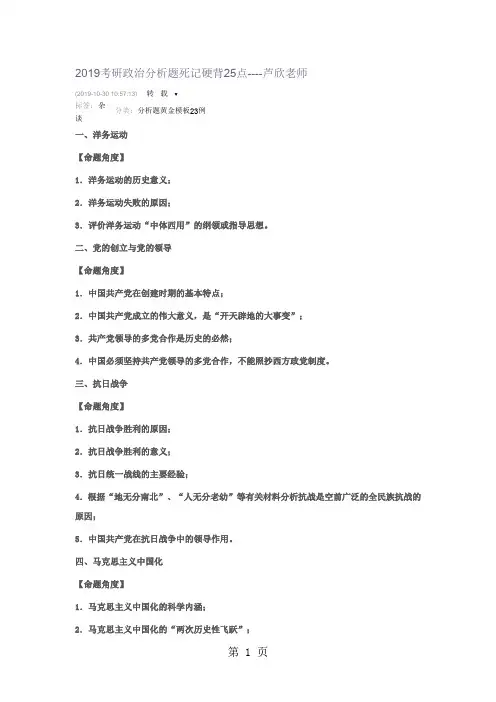
2019考研政治分析题死记硬背25点----芦欣老师(2019-10-30 10:57:13)转载▼标签:杂分类:分析题黄金模板23例谈一、洋务运动【命题角度】1.洋务运动的历史意义;2.洋务运动失败的原因;3.评价洋务运动“中体西用”的纲领或指导思想。
二、党的创立与党的领导【命题角度】1.中国共产党在创建时期的基本特点;2.中国共产党成立的伟大意义,是“开天辟地的大事变”;3.共产党领导的多党合作是历史的必然;4.中国必须坚持共产党领导的多党合作,不能照抄西方政党制度。
三、抗日战争【命题角度】1.抗日战争胜利的原因;2.抗日战争胜利的意义;3.抗日统一战线的主要经验;4.根据“地无分南北”、“人无分老幼”等有关材料分析抗战是空前广泛的全民族抗战的原因;5.中国共产党在抗日战争中的领导作用。
四、马克思主义中国化【命题角度】1.马克思主义中国化的科学内涵;2.马克思主义中国化的“两次历史性飞跃”;3.马克思主义中国化的基本经验;4.马克思主义之所以能够在中国扎根生长的主要原因。
五、正确处理人民内部矛盾、建设社会主义和谐社会【命题角度】1.毛泽东关于正确处理人民内部矛盾思想的主要内容;2.正确处理人民内部矛盾、建设社会主义和谐社会的主要措施。
六、经济发展方式转变【命题角度】1.根据科学发展观的要求,促进国民经济又好又快发展,实现经济发展方式的彻底转变;(1)粗放型向集约型转变(2)投资拉动向创新拉动转变(3)外向型经济向内需型转变(扩大内需改善民生和发展经济)2.扩大内需,由外向型经济转向内需导向型;3.统筹国内发展和各国共同发展,在对外开放中促进经济发展方式转变;4.提高自主创新能力,以科技进步和创新作为经济发展方式转变的重要支撑。
七、保障和改善民生【命题角度】1.收入分配改革,重点是增加低收入群体收入,让低收入群体受益,甚至更多地受益;2.房地产政策调整;3.物价调控。
八、坚持公有制主体地位,鼓励、引导和发展非公有制经济,反对私有化和单一公有制【解题思路】1.坚持公有制主体地位的主要依据;2.坚持公有制主体地位的主要措施;3.坚持公有制主体地位,反对私有化和单一公有制;4.发展非公有制经济的重要作用;5.发展非公有制经济的主要措施。
2019年考研政治复习资料1156
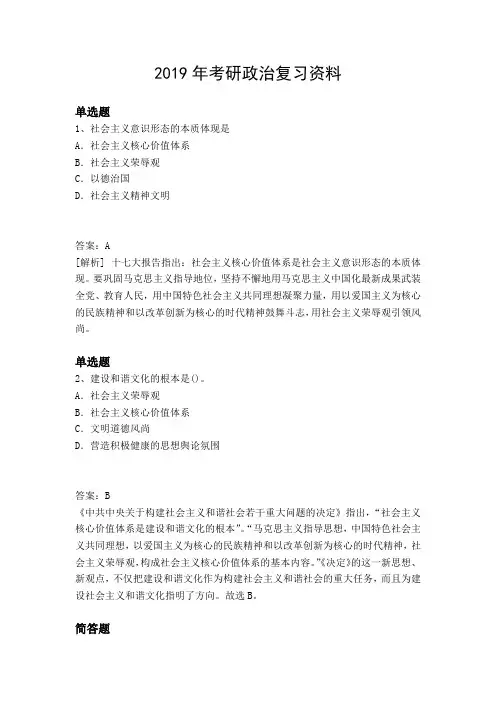
2019年考研政治复习资料单选题1、社会主义意识形态的本质体现是A.社会主义核心价值体系B.社会主义荣辱观C.以德治国D.社会主义精神文明答案:A[解析] 十七大报告指出:社会主义核心价值体系是社会主义意识形态的本质体现。
要巩固马克思主义指导地位,坚持不懈地用马克思主义中国化最新成果武装全党、教育人民,用中国特色社会主义共同理想凝聚力量,用以爱国主义为核心的民族精神和以改革创新为核心的时代精神鼓舞斗志,用社会主义荣辱观引领风尚。
单选题2、建设和谐文化的根本是()。
A.社会主义荣辱观B.社会主义核心价值体系C.文明道德风尚D.营造积极健康的思想舆论氛围答案:B《中共中央关于构建社会主义和谐社会若干重大问题的决定》指出,“社会主义核心价值体系是建设和谐文化的根本”。
“马克思主义指导思想,中国特色社会主义共同理想,以爱国主义为核心的民族精神和以改革创新为核心的时代精神,社会主义荣辱观,构成社会主义核心价值体系的基本内容。
”《决定》的这一新思想、新观点,不仅把建设和谐文化作为构建社会主义和谐社会的重大任务,而且为建设社会主义和谐文化指明了方向。
故选B。
简答题3、构建社会主义和谐社会的指导思想是什么答案:(1)必须坚持以马克思主义、毛泽东思想、邓小平理论和“三个代表”重要思想为指导,坚持党的基本路线、基本纲领、基本经验,坚持以科学发展观统领经济社会发展全局。
暂无解析多选题4、中国共产党在过渡时期的总路线,是党和毛泽东根据列宁关于过渡时期学说,是在借鉴苏联经验,总结我国国民经济恢复时期实践经验的基础上提出来的。
它符合中国由新民主主义向社会主义转变的历史必然性,具体表现为A.实现工业化是国家独立和富强的物质基础和必要条件B.实现工业化是消灭城乡差别、工农差别乃至阶级差别的根本途径C.实现国家工业化和建立社会主义制度的迫切需要D.实现工业化是发展农业和提高整个社会生产力的客观需要答案:A,C,D[解析] 党在过渡时期的总路线,是党在我国历史发展的关键时刻采取的一个重大战略步骤,完全符合中国由新民主主义向社会主义转变的历史必然:第一,实现国家工业化,是国家独立和富强的物质基础和必要条件;第二,对资本主义工商业进行全面的社会主义改造,是迅速实现国家工业化和建立社会主义制度的迫切需要;第三,对个体农业和手工业进行社会主义改造,是发展农业和提高整个社会生产力的客观需要,因而,ACD项正确。
2019年考研政治复习资料8579
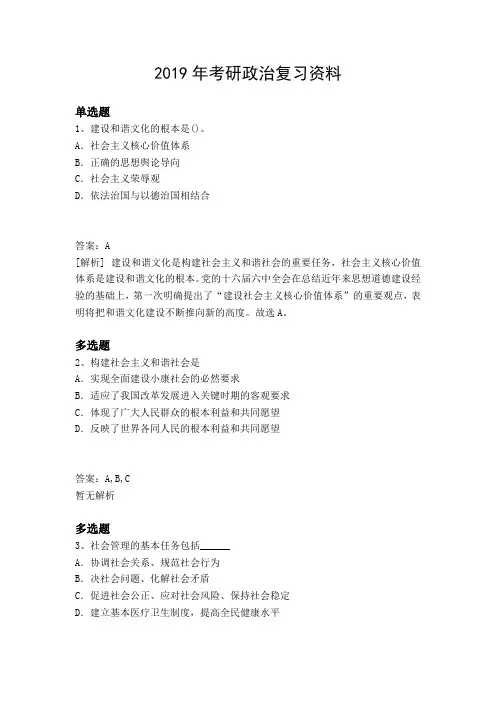
2019年考研政治复习资料单选题1、建设和谐文化的根本是()。
A.社会主义核心价值体系B.正确的思想舆论导向C.社会主义荣辱观D.依法治国与以德治国相结合答案:A[解析] 建设和谐文化是构建社会主义和谐社会的重要任务,社会主义核心价值体系是建设和谐文化的根本。
党的十六届六中全会在总结近年来思想道德建设经验的基础上,第一次明确提出了“建设社会主义核心价值体系”的重要观点,表明将把和谐文化建设不断推向新的高度。
故选A。
多选题2、构建社会主义和谐社会是A.实现全面建设小康社会的必然要求B.适应了我国改革发展进入关键时期的客观要求C.体现了广大人民群众的根本利益和共同愿望D.反映了世界各同人民的根本利益和共同愿望答案:A,B,C暂无解析多选题3、社会管理的基本任务包括______A.协调社会关系、规范社会行为B.决社会问题、化解社会矛盾C.促进社会公正、应对社会风险、保持社会稳定D.建立基本医疗卫生制度,提高全民健康水平答案:A,B,C[解析] 本题考查建设和谐社会中提高社会管理科学化水平的基本任务。
社会管理的基本任务包括协调社会关系、规范社会行为、解决社会问题、化解社会矛盾、促进社会公正、应对社会风险、保持社会稳定等方面。
做好社会管理工作,促进社会和谐,是全面建设小康社会、坚持和发展中国特色社会主义的基本条件。
因此ABC正确。
D是改善医疗的内容,故不选。
单选题4、公司新近任命原经营经理出任首席审计执行官。
新任的审计执行官既不是国际注册内部审计师,也不是ⅡA的成员。
内部审计活动的工作是严格按照审计执行官的要求开展的,而非ⅡA的标准。
4名助理内部审计人员都是ⅡA的会员,但都不是国际注册内部审计师。
依据ⅡA的道德规范,助理审计人员的最佳行动方案是:A.鉴于他们都不是国际注册内部审计师,因此不需要遵守职业道德规范。
B.应遵守内部审计专业实务标准。
C.必须尊重组织的法律地位和道德目标,可忽视内部审计专业实务标准。
2019年考研政治复习题含答案9939
2019年考研政治复习题含答案简答题1、构建社会主义和谐社会的指导思想是什么答案:(1)必须坚持以马克思主义、毛泽东思想、邓小平理论和“三个代表”重要思想为指导,坚持党的基本路线、基本纲领、基本经验,坚持以科学发展观统领经济社会发展全局。
暂无解析多选题2、“三个代表”重要思想最鲜明的特点和最突出的贡献是A.进一步回答了什么是社会主义、怎样建设社会主义的问题B.创造性地回答了在长期执政的历史条件下建设什么样的党、怎样建设党的问题C.深化了我们对新时代条件下推进中国特色社会主义事业和加强党的建设规律的认识D.创造性地回答了为什么发展、怎样发展的重大问题答案:A,B,C暂无解析多选题3、中国特色社会主义是物质文明、政治文明、精神文明的全面发展,因为A.三个文明构成了有中国特色社会主义建设的基本内容B.物质文明为政治文明和精神文明提供物质基础C.政治文明为物质文明和精神文明提供政治保证和政治动力D.精神文明为物质文明和政治文明提供精神动力和智力支持答案:A,B,C,D[解析] 考查对三个文明之间的关系的理解和掌握。
在社会主义现代化建设中,物质文明、政治文明和精神文明建设之间存在着互为条件、互为目的、相互促进的关系,它们共同推动社会主义单选题4、有中国特色社会主义文化建设的根本,是:A.在全社会形成共同理想和精神支柱B.发展教育和科学C.营造良好的文化环境D.深化文化体制改革答案:A本题是考查中国社会主义建设有关精神文明建设的试题,考查考生对社会主义文化建设的根本任务的了解。
有中国特色社会主义的文化,就其主要内容来说,同改革开放以来,我们倡导的社会主义精神文明是一致的。
只有政治、经济、文化协调发展,两个文明都搞好了,才是有中国特色的社会主义。
有中国特色社会主义的文化,是凝聚和激励全国各族人民的重要力量.是综合国力的重要标志。
而在全社会形成共同的理想和精神支柱,是有中国特色社会主义文化建设的根本。
因此,选择A项是正确的。
2019年考研政治复习资料9699
2019年考研政治复习资料多选题1、党的十六大把“社会更加和谐”作为全面建设小康社会的目标之一提出来,党的十六届四中全会又把“提高构建社会主义和谐社会的能力”作为党执政能力的一个重要方面明确提出,这在我们党的历史上还是第一次。
和谐社会的内涵包括A.民主法治、公平正义B.诚信友爱、充满活力C.安定有序D.人与自然和谐相处答案:A,B,C,D[解析] 胡锦涛指出,构建社会主义和谐社会,是我们党从全面建设小康社会、开创中国特色社会主义事业新局面的全局出发提出的一项重大任务,适应了我国改革发展进入关键时期的客观要求,体现了广大人民群众的根本利益和共同愿望。
社会主义和谐社会,应该是民主法治、公平正义、诚信友爱、充满活力、安定有序、人与自然和谐相处的社会。
简答题2、传统的思想政治课教学中,教师更注重学生的学习成绩,而忽视对学生情感、态度、价值观的培养。
[问题]运用新课程理念,就如何解决这一问题谈谈你的看法。
答案:思想政治课作为对中学生系统进行公民品德教育和马克思主义常识教育的必修课程,同时也是中学德育工作的主要途径,应改变“重视智育,忽视德育;重视结果,忽视过程;重视科学精神,忽视人文素养;重视眼前的学业成绩,忽视学生终身发展”的错误价值取向,努力实现学生德智体美全面发展。
暂无解析多选题3、党的十六大强调:“必须尊重劳动、尊重知识、尊重人才、尊重创造作为党和国家的一项重大方针在全社会认真贯彻。
”把“四个尊重”作为一项重大方针其必要性有______A.是时代发展对党和国家工作提出的新要求B.是中国共产党代表中国先进生产力发展要求的具体C.在全社会形成与社会主义初级阶段基本经济制度相适应的思想观念和创业机制D.有利于增强全社会的创造活力答案:A,B,C,D[解析] 本题考查劳动、知识、人才、创造之间的关系。
胡锦涛在庆祝党成立90周年大会上的讲话中强调:“人才是第一资源,是国家发展的战略资源。
全党同志和全社会都要坚持尊重劳动、尊重知识、尊重人才、尊重创造的重大方针,牢固树立人人皆可成才的观念,敢为事业用人才,让各类人才都拥有广阔的创业平台、发展空间,使每个人都成为对祖国、对人民、对民族的有用人才,特别是要抓紧培养造就青年英才,形成人才辈出、人尽其才、人尽其用的生动局面”。
2019年考研政治经典复习资料(彩版)
2014年12月大学英语四级考试真题(第一套)Part I Writing(30minutes)Directions:For this part,.you are allowed30minutes to write a short essay about a classmate of yours who has influenced you most in college.You shouldwrite at least120words but No more than180words.Part II Listening Comprehension(30minutes) Section ADirections:In this section,you will hear8short conversations and2long conversations.At the end of each conversation,one or more questionswill be asked about what was said.Both the conversation and thequestions will be spoken only once.After each question there will be apause.During the pause,you must read the four choices marked A),B),C)and D),and decide which is the best answer.Then mark thecorresponding letter on Answer Sheet I with a single line through thecentre.1.A)The woman is fussy about the cleanness of the apartment.B)He has not cleaned the apartment since his mother’s visit.C)He does not remember when his mother canoe over.D)His mother often helps him to clean the apartment.2.A)The bus stop is only two minutes’walk.B)The running made him short of breath.C)They might as well take the next bus.D)The woman is late by a couple of minutes.3.A)She is suffering a pain in her neck.B)She is likely to replace Miss Smith.C)She has to do extra work for a few days.D)She is quite sick of working overtime.4.A)Change her job.B)Buy a dishwasher.C)Open a flower shop.D)Start her own business.5.A)He forgot where he had left the package.B)He slipped on his way to the post office.C)He wanted to deliver the package himself.D)He failed to do what he promised to do.6.A)The speakers do not agree with each other.B)The woman does not like horror films.C)The man pays for the tickets as a rule.D)The speakers happened to meet in the cinema.7.A)The woman is just as unlucky as the man.B)The woman is more sensitive than the man.C)The speakers share a common view on love.D)The speakers are unhappy with their marriage.8.A)Preparations for a forum.B)Participants in the forum.C)Organizers of a forum.D)Expectations of the forum.Questions9to11are based on the conversation you have just heard.9.A)France.B)Scandinavia.C)Russia.D)East Europe.10.A)More women will be promoted in the workplace.B)More women will overcome their inadequacies.C)More women will receive higher education.D)More women will work outside the family.11.A)Try hard to protect women’s rights.B)Educate men to respect women more.C)Help women acquire more professional skills.D)Spend more time changing women’s attitudes.Questions12to15are based on the conversation you have just heard.12.A)In a restaurant.B)In a hotel lobby.C)At the man’s office.D)At the woman’s place.13.A)He is the chief designer of the latest bike model.B)He has completed an overseas market survey.C)He is the Managing Director of Jayal Motors.D)He has just come back from a trip to Africa.14.A)To select the right model.B)To get a good import agent.C)To convince the board members.D)To cut down production costs.15.A)His flexibility.B)His vision.C)His intelligence.D)His determination.Section BDirections:In this section,you will hear3short passages.At the end of each passage, you will hear some questions.Both the passage and the questions will bespoken only once.After you hear a question,you must choose the bestanswer from the four choices marked A),B),C)and D).Then mark thecorresponding letter on Answer Sheet I with a single line through thecentre.Passage OneQuestions16to18are based on the passage you have just heard.16.A)How being an identical twin influences one’s identity.B)Why some identical twins keep their identities secret.C)Why some identical twins were separated from birth.D)How identical twins are born,raised and educated.17.A)Their second wives were named Linda.B)They grew up in different surroundings.C)Their first children were both daughters.D)They both got married when they were39.18.A)They want to find out the relationship between environment and biology.B)They want to see what characteristics distinguish one from the other.C)They want to understand how twins communicate when far apart.D)They want to know whether twins can feel each other’s pain.Passage TwoQuestions19to21are based on the passage you have just heard.19.A)It is especially attractive to children and the young.B)It is the first choice of vacationers on the Continent.C)It is as comfortable as living in a permanent house.D)It is an inexpensive way.of spending a holiday.20.A)It has a solid plastic frame.B)It consists of an inner and an outer tent.C)It is very convenient to set up.D)It is sold to many Continental countries.21.A)A groundsheet.B)A gas stove.C)A kitchen extension.D)A spare tent.Passage ThreeQuestions22to25are based on the passage you have just heard.22.A)It covers179square miles.B)It is as big as New York City.C)It covers97square kilometers.D)It is only half the size of Spain.23.A)Its geographic features attracted many visitors.B)Its citizens enjoyed a peaceful,comfortable life.C)It imported food from foreign countries.D)It was cut off from the rest of the world.24.A)The fast development of its neighboring countries.B)The increasing investment by developed countries.C)The building of roads connecting it with neighboring countries.D)The establishing of diplomatic relations with France and Spain.25.A)They work on their farms.B)They work in the tourist industry.C)They raise domestic animals.D)They make traditional handicrafts.Section CDirections:In this section,you will hear a passage three times.When the passage is read for the first time,you should listen carefully for its general idea.When the passage is read for the second time,you are required to fill inthe blanks with the exact words you have just heard.Finally,when thepassage is read for the third time,you should check what you havewritten.“Don’t take many English courses;they won’t help you get a decent job.”“Sign up for management classes,so you’ll be ready to join the family business when you graduate.”Sound26?Many of us have heard suggestions like these27by parents or others close to us.Such comments often seem quite reasonable.Why,then,should suggestions like these be taken with28?The reason is they relate to decisions you should make.You are the one who must29their consequences.One of the worst reasons to follow a particular path in life is that other people want you to.Decisions that affect your life should be your decisions—decisions you make after you’ve considered various30and chosen the path that suits you best.Making your own decisions does not mean that you should31the suggestions of others.For instance,your parents do have their own unique experiences that may make their advice helpful,and having32in a great deal of your personal history,they may have a clear view of your strengths and weaknesses. Still,their views are not necessarily accurate.They may still see you as a child,33 care and protection.Or they may see only your strengths.Or,in some unfortunate cases,they may34your flaws and shortcomings.People will always be giving you advice.Ultimately,though,you have to make your own35.Part III Reading Comprehension(40minutes) Section ADirections:In this section,there is a passage with ten blanks.You are required to select one word for each blank from a list of choices given in a wordbank following the passage:Read the passage through carefully beforemaking your choices.Each choice in the bank is identified by a letter.Please mark the corresponding letter for each item on Answer Sheet2with a single line through the centre.You may not use any of the words inthe bank more than once.Questions36to45are based on the following passage.One principle of taxation,called the benefits principle,states that people should pay taxes based on the benefits they receive from government services.This principle tries to make public goods similar to36goods.It seems reasonable that a person who often goes to the movies pays more in37for movie tickets than a person who rarely goes.And38,a person who gets great benefit from a public good should pay more for it than a person who gets little benefit.The gasoline tax,for instance,is sometimes39using the benefits principle. In some states,40from the gasoline tax are used to build and maintain roads. Because those who buy gasoline are the same people who use the roads,the gasoline tax might be viewed as a41way to pay for this government service.The benefits principle can also be used to argue that wealthy citizens should pay higher taxes than poorer ones,42because the wealthy benefit more from public services.Consider,for example,the benefits of police protection from43.Citizens with much to protect get greater benefit from police than those with less to protect. Therefore,according to the benefits principle,the wealthy should44more than the poor to the cost of45the police force.The same argument can be used for many other public services,such as fire protection,national defense,and the court system.A)adaptB)contributeC)exertingD)expensesE)fairF)justifiedG)maintainingH)private I)provided J)revenues K)similarly L)simply M)theft N)total O)wealthSection BDirections:In this section,you are going to read a passage with ten statements attached to it.Each statement contains information given in one of theparagraphs.Identify the paragraph from which the information is derived.You may choose a paragraph more than once.Each paragraph is markedwith a letter.Answer the questions by marking the corresponding letteron Answer Sheet2.Grow up Colored[A]You wouldn’t know Piedmont anymore—my Piedmont,I mean—the town inWest Virginia where I learned to be a colored boy.[B]The1950s in Piedmont was a time to remember,or at least to me.People werealways proud to be from Piedmont—lying at the foot of a mountain,on the banks of the mighty Potomac.We knew God gave America no more beautiful location.I never knew colored people anywhere who were crazier about mountains andwater,flowers and trees,fishing and hunting.For as long as anyone could remember,we could outhunt,outshoot,and outswim the white boys in the valley.[C]The social structure of Piedmont was something we knew like the back of ourhands.It was an immigrant town;white Piedmont was Italian and Irish,with a handful of wealthy WASPs(盎格鲁撒克逊裔的白人新教徒)on East Hampshire Street,and"ethnic"neighborhoods of working-class people everywhere else, colored and white.[D]For as long as anyone can remember,Piedmont’s character has been completelybound up with the Westvaco paper mill:its prosperous past and doubtful future.At first glance,the town is a typical dying mill center.Many once beautiful buildings stand empty,evidencing a bygone time of spirit and pride.The big houses on East Hampshire Street are no longer proud,as they were when I was a kid.[E]Like the Italians and the Irish,most of the colored people migrated to Piedmont atthe turn of the20th century to work at the paper mill,which opened in1888.All the colored men at the paper mill worked on“the platform”—loading paper into trucks until the craft unions were finally integrated in1968.Loading is what Daddy did every working day of his life.That’s what almost every colored grown-up I knew did.[F]Colored people lived in three neighborhoods that were clearly separated.Welcometo the Colored Zone,a large stretched banner could have said.And it felt good in there,like walking around your house in bare feet and underwear,or snoring(打鼾)right out loud on the couch in front of the TV—enveloped by the comforts of home,the warmth of those you love.[G]Of course,the colored world was not so much a neighborhood as a condition ofexistence.And though our own world was seemingly self-contained,it impacted on the white world of Piedmont in almost every direction.Certainly,the borders of our world seemed to be impacted on when some white man or woman showed up where he or she did not belong,such as at the black Legion Hail.Our space was violated when one of them showed up at a dance or a party.The rhythms would be off.The music would sound not quite right.Everybody would leave early.[H]I Before1955,most white people were just shadowy presences in our world,vague figures of power like remote bosses at the mill or clerks at the bank.There were exceptions,of course,the white people who would come into our world in routine,everyday ways we all understood.Mr.Mail Man,Mr.Insurance Man,Mr.White-and-Chocolate Milk Man,ndlord Man,Mr.Police Man:we called white people by their trade,like characters in a mystery play.Mr.Insurance Man would come by every other week to collect payments on college or death policies, sometimes50cents or less.[I]“It’s no disgrace to be colored,”the black entertainer Bert Williams famouslyobserved early in the century,“but it is awfully inconvenient.”For most of my childhood,we couldn’t eat in restaurants or sleep in hotels,we couldn’t use certain bathrooms or try on clothes in stores.Mama insisted that we dress up when we went to shop.She was carefully dressed when she went to clothing stores,and wore white pads called shields under her arms so her dress or blouse would show no sweat.“We’d like to try this on,”she’d say carefully,uttering her words precisely and properly.“We don’t buy clothes we can’t try on,”she’d say when they declined,and we’d walk out in Mama’s dignified(有尊严的)manner.She preferred to shop where we had an account and where everyone knew who she was.[J]At the Cut-Rate Drug Store,no one colored was allowed to sit down at the counter or tables,with one exception:my father.I don’t know for certain why Carl Dadisman,the owner,wouldn’t stop Daddy from sitting down.But I believe it was in part because Daddy was so light-colored,and in part because,during his shift at the phone company,he picked up orders for food and coffee for the operators.Colored people were supposed to stand at the counter,get their food to go,and leave.Even when Young Doc Bess would set up the basketball team with free Cokes after one of many victories,the colored players had to stand around and drink out of paper cups while the white players and cheerleaders sat down in comfortable chairs and drank out of glasses.[K]I couldn’t have been much older than five or six as I sat with my father at the Cut-Rate one afternoon,enjoying ice cream.Mr.Wilson,a stony-faced Irishman, walked by.“Hello,Mr.Wilson,”my father said.“Hello,George.”[L]I was genuinely puzzled.Mr.Wilson must have confused my father with somebody else,but who?There weren’t any Georges among the colored people in Piedmont.“Why don’t you tell him your name,Daddy?”I asked loudly.“Your name isn’t George.”“He knows my name,boy,”my father said after a long pause.“He calls all colored people George.”[M]I knew we wouldn’t talk about it again;even at that age,I was given to understand that there were some subjects it didn’t do to worry to death about.Now that I have children,I realize that what distressed my father wasn’t so much the Mr.Wilsons of the world as the painful obligation to explain the racial facts of life to someone who hadn’t quite learned them yet.Maybe Mr.Wilson couldn’t hurt my father by calling him George;but I hurt him by asking to know why.46.The author felt as a boy that his life in a separated neighborhood was casual andcozy.47.There is every sign of decline at the paper mill now.48.One reason the author’s father could sit and eat at the drug store was that hedidn’t look that dark.49.Piedmont was a town of immigrants from different parts of the world.50.In spite of the awful inconveniences caused by racial prejudice,the author’sfamily managed to live a life of dignity.51.The author later realized he had caused great distress to his father by asking whyhe was wrongly addressed.52.The author took pride in being from Piedmont because of its natural beauty.53.Colored people called white people by the business they did.54.Colored people who lived in Piedmont did heavy manual jobs at the paper mill.55.The colored people felt uneasy at the presence of the whites in theirneighborhoods.Section CDirections:There are2passages in this section.Each passage is followed by some questions or unfinished statements.For each of them there are fourchoices marked A),B),C)and D).You should decide on the best choiceand mark the corresponding letter on Answer Sheet2with a single linethrough the centre.Passage OneQuestions56to60are based on following passage.Children are a delight.They are our future.But sadly,hiring someone to take care of them while you go to work is getting more expensive by the year.Earlier this month,it was reported that the cost of enrolling an infant or small kid at a childcare center rose3%in2012,faster than the overall cost of living.There are now large strips of the country where daycare for an infant costs more than a tenth of the average married couple’s income.This is not necessarily a new trend,but it is a somewhat puzzling one.The price of professional childcare has been rising since the1980s.Yet during that time,pay for professional childcare workers has stood still.Actually caregivers make less today,in real terms,than they did in1990.Considering that labor costs are responsible for up to 80%of a daycare center’s expenses,one would expect flat wages to have meant flat prices.So who’s to blame for higher childcare costs?Childcare is a carefully regulated industry.States lay down rules about how many children each employee is allowed to watch over,the space care centers need per child,and other minute details.And the stricter the regulations,the higher the costs.If it has to hire a caregiver for every two children,it can’t really achieve any economies of scale on labor to save money when other expenses go up.In Massachusetts,where childcare centers must hire one teacher for every three infants, the price of care averaged more than$16,000per year.In Mississippi,where centers must hire one teacher for every five infants,the price of care averaged less than $5,000.Unfortunately,I don’t have all the daycare-center regulations handy.But I wouldn’t be surprised if as the rules have become more elaborate,prices have risen. The tradeoff(交换)might be worth it in some cases;after all,the health and safety of children should probably come before cheap service.But certainly,it doesn’t seem to be an accident that some of the cheapest daycare available is in the least regulated South.56.What problem do parents of small kids have to face?A)The ever-rising childcare prices.B)The budgeting of family expenses.C)The balance between work and family.D)The selection of a good daycare center.57.What does the author feel puzzled about?A)Why the prices of childcare vary greatly from state to state.B)Why increased childcare prices have not led to better service.C)Why childcare workers’pay has not increased with the rising childcare costs.D)Why there is a severe shortage of childcare professionals in a number ofstates.58.What prevents childcare centers from saving money?A)Steady increase in labor costs.B)Strict government regulations.C)Lack of support from the state.D)High administrative expenses.59.Why is the average cost of childcare in Mississippi much lower than inMassachusetts?A)The overall quality of service is not as good.B)Payments for caregivers there are not as high.C)Living expenses there are comparatively low.D.Each teacher is allowed to care for more kids.60.What is the author’s view on daycare service?A)Caregivers should receive regular professional training.B)Less elaborate rules about childcare might lower costs.C)It is crucial to strike a balance between quality and costs.D)It is better for different states to learn from each other.Passage TwoQuestions61to65are based on the following passage.Alex Pang’s amusing new book The Distraction Addiction addresses those of us who feel panic without a cellphone or computer.And that,he claims,is pretty much all of us.When we’re not online,where we spend four months annually,we’re engaged in the stressful work of trying to get online.The Distraction Addiction is not framed as a self-help book.It’s a thoughtful examination of the dangers of our computing overdose and a historical overview of how technological advances change consciousness.A“professional futurist”,Pang urges an approach which he calls“contemplative(沉思的)computing.”He asks that you pay full attention to“how your mind and body interact with computers and how your attention and creativity are influenced by technology.”Pang’s first job is to free you from the common misconception that doing two things at once allows you to get more done.What is commonly called multitasking is,in fact,switch-tasking,and its harmful effects on productivity are well documented. Pang doesn’t advocate returning to a pre-Internet world.Instead,he asks you to“take a more ecological(生态的)view of your relationships with technologies and look for ways devices or media may be making specific tasks easier or faster but at the same time making your work and life harder.”The Distraction Addiction is particularly fascinating on how technologies have changed certain fields of labor-often for the worse.For architects,computer-aided design has become essential but in some ways has cheapened the design process.As one architect puts it,“Architecture is first and foremost about thinking..,and drawing is a more productive way of thinking”than computer-aided design.Somewhat less amusing are Pang’s solutions for kicking the Internet habit.He recommends the usual behavior-modification approaches,familiar to anyone who has completed a not smoking program.Keep logs to study your online profile and decide what you can knock out,download a program like Freedom that locks you out of your browser,or take a“digital Sabbath(安息日)”:“Unless you’re a reporter or emergency-department doctor,you’ll discover that your world doesn’t fall apart when you go offline.”61.Alex Pang’s new book is aimed for readers who______.A)find their work online too stressfulB)go online mainly for entertainmentC)are fearful about using the cellphone or computerD)can hardly tear themselves away from the Internet62.What does Alex Pang try to do in his new book?A)Offer advice on how to use the Internet effectively.B)Warn people of the possible dangers of Internet use.C)Predict the trend of future technological development.D)Examine the influence of technology on the human mind.63.What is the common view on multitasking?A)It enables people to work more effectively.B)It is in a way quite similar to switch-tasking.C)It makes people’s work and life even harder.D)It distracts people’s attention from useful work.64.What does the author think of computer-aided design?A)It considerably cuts down the cost of building design.B)It somewhat restrains architects’productive thinking.C)It is indispensable in architects’work process.D)It can free architects from laborious drawing.65.What is Alex Pang’s recommendation for Internet users?A)They use the Internet as little as possible.B)They keep a record of their computer use time.C)They exercise self-control over their time online.D)They entertain themselves online on off-days only.Part IV Translation(30minutes) Directions:For this part,you are allowed30minutes to translate a passage from Chinese into English.You should write your answer on Answer Sheet2.越来越多的中国年轻人正对旅游产生兴趣,这是近年来的新趋势。
2019年考研政治复习资料5443
2019年考研政治复习资料多选题1、我国会计职业道德规范的坚持准则,其基本要求为()。
A.熟悉准则,提高会计人员遵守准则的能力B.依照准则办事,提高会计人员执行准则的能力C.正确运用准则D.提高执行准则的技能答案:A,B,C,D暂无解析单选题2、马克思:唯物史观A.新民主主义理论:毛泽东B.列宁:武装斗争理论C.邓小平:改革开放理沦D.思格斯:科学发展观答案:C唯物史观是马克思所创立,改革开放理论为邓小平所创立。
单选题3、()是建设有中国特色的社会主义理论的精髓。
A.一国两制B.以经济建设为中心C.坚持四项基本原则,坚持改革开放D.解放思想,实事求是答案:D[解析] 解放思想,实事求是,是邓小平理论的精髓,同样也是建设有中国特色的社会主义理论的精髓,因为它是建设有中国特色的社会主义理论的一部分。
正确答案为D。
单选题4、“一国两制”的前提是A.国家主权统一于中华人民共和国B.港、澳、台实行高度自治C.社会主义制度D.港、澳、台资本主义制度不变答案:A[命题出处] 《中国社会主义建设》:“一国两制”的内容。
现属于《邓小平理论和“三个代表”重要思想概论》第十章。
[思路剖析] “一国两制”是我国为实现祖国统一大业而制定的一项战略方针,是在“一国”的前提下,港、澳、台地区可设立特别行政区,享有高度自治权。
此题供选择的答案,都是讲“一国两制”的内容。
其中,“一国两制”的前提、基础和核心是“一个中国”,即“国家主权统―于中华人民共和国”。
由此可见,正确选项是A。
[必背考点] “一国两制”的内容。
[应试对策] “一国两制”是我国为实现祖国统一大业而制定的一项战略方针,在复习中要认真把握其概念的内涵、重要意义等问题。
单选题5、马克思:唯物史观A.新民主主义理论:毛泽东B.列宁:武装斗争理论C.邓小平:改革开放理沦D.思格斯:科学发展观答案:C唯物史观是马克思所创立,改革开放理论为邓小平所创立。
多选题6、过渡时期总路线的“两翼”是()A.对资本主义工商业的社会主义改造B.对农业的社会主义改造C.对手工业的社会主义改造D.实现国家的社会主义工业化答案:A,B,C[考查要点] 本题考查考生对过渡时期总路线基本内容的把握。
- 1、下载文档前请自行甄别文档内容的完整性,平台不提供额外的编辑、内容补充、找答案等附加服务。
- 2、"仅部分预览"的文档,不可在线预览部分如存在完整性等问题,可反馈申请退款(可完整预览的文档不适用该条件!)。
- 3、如文档侵犯您的权益,请联系客服反馈,我们会尽快为您处理(人工客服工作时间:9:00-18:30)。
2019年考研政治经典复习资料一、马克思主义哲学核心考点1,唯物主义和唯心主义(一)★哲学是系统化理论化的世界观,是世界观的理论体系(1)一切哲学都不能调和唯物主义和唯心主义两大基本派别,这是哲学的党性(2)唯物主义主张物质第一、精神第二,按世界的本来面目去说明世界,不附加外来成分。
(3)唯心主义主张精神第一性、物质第二性。
(把握唯心主义的两个基本形态)①主观唯心主义把人的感觉、观念作为唯一真实的存在和世界的本原;(唐刘禹锡唯物)②客观唯心主义把某种脱离个人的精神变为独立的存在,作为世界本原和万物创造者。
(4)唯心主义产生的根源:(感觉是屏障,不可知论)(马克思和旧唯物最主要区别:唯物史观)①阶级根源:在阶级社会,唯心主义哲学受到反动没落的社会阶级的拥护和利根源不能说主观和客观相背离,因为它是认识错误的原因,可以是教条主义经验主义的错误②社会根源:社会分工、脑体劳动分离,为片面夸大精神意识的作用提供了条件。
③认识论根源:在认识过程中,将认识的某一特征、方面、部分加以夸大。
将认识过程中的感性阶段夸大、绝对化,导致主观唯心主义。
将认识过程中的理性阶段夸大、绝对化,导致客观唯心主义(5)旧唯物主义的缺陷:机械性、形而上学性、不彻底性,没有确立科学的实践观(重点把握)(6)马克思主义的特点:(马克思最伟大的贡献:创立唯物史观;)(旧唯物半截子是因为自然观唯物,历史观唯心;)①阶级性---公开申明为谁服务;(一切辩证法都认为世界是普遍联系的,发展变化的。
没有认为世界统一)②实践性---强调理论对实践的依赖关系,理论反过来又指导实践。
(解决问题的出发点----实践)③革命性与科学性的统一,革命性建立在科学性基础之上,即正确认识事物的(7)马哲与具体科学的关系:一般与个别;抽象与具体;指导与被指导;普遍与特殊。
2,解放思想、实事求是、与时俱进(一)①实事求是:一切从实际出发,从中找出其固有的规律性,作为我们行动的向导。
②解放思想:在马克思主义指导下,破除不符合实际的旧观念,研究新情况,解决新问题,使主观与客观相符合③与时俱进:马克思主义理论及其指导下的实践要体现时代性、把握规律性、富于创造性。
④解放思想是前提,实事求是是核心,与时俱进、开拓创新是目的,三者相互依存、相互促进。
3,辩证唯物主义和历史唯物主义的作用(多选把握)(一)①揭示人类社会的本质和发展规律,为我们理解社会提供思想武器。
唯心不是改造世界的思想武器②为我们认识社会提供了辩证法原则,我们要用联系和发展的观点认识社会。
③帮助人们树立正确的世界观、人生观和价值观。
④提高人们对社会发展、社会管理规律的认识和运用能力。
4①科学主义否定哲学世界观功能,推崇科学知识,放弃世界观的研究。
②人本主义反对科学和理性,强调人的存在的本体论(不是以人为本),具有非理性主义的特点。
5,世界的物质性和人的实践活动(二)庸俗唯物主义的错误是抹杀了意识的主观特征①物质是不依赖于人的意识并能为人的意识所反映的客观实在。
物质定义的意义:三个划清界限---同唯心主义和二元论、同不可知论、同旧唯物主义。
(正确理解物质范畴要把握自然物质的多样性,客观实在性。
)②客观实在是物质的共同的一般本质,它通过运动表现出来。
③运动是物质的存在方式和根本属性。
运动和物质不可分离,设想没有运动的物质是机械唯物论;设想没有物质的运动是唯心论。
运动和静止都是物质的固有属性,运动绝对,静止相对,他们相互包含。
④静止是运动的特殊状态。
相对静止使事物呈现多样性,是区分事物基础,衡量事物运动尺度。
⑤实践是人能动地改造物质世界的对象性活动。
形式:生产、处理和变革社会关系和科学实验。
⑥实践有三个基本特征:客观现实性、自觉能动性和社会历史性。
实践目的、手段、结果的反馈调节。
⑦主体是指从事实践活动和认识活动的人,客体是主体活动对象的总和。
实践活动就是以主体、中介和客体为基本骨架的动态系统,通过实践活动使客体主体化,使主体客体化。
6,自在世界和人类世界及其与人的实践活动的关系(二)①主观世界:人的意识、观念世界,是人的头脑反映和把握物质世界的精神活动、心理活动的总和;(存在主义所谓的存在是指“个人的存在”),(主体和客体相互作用的实质是主体和客体之间的限定和超越的关系)②客观世界:物质的,可以感知的世界,人的意识之外的一切物质运动的总和,包括自然存在和社会存在。
(主体和客体的关系:目的和手段;创造者和被创造者;能动者和被动者)③自在世界(天然自然),是人类世界产生前的先在世界,是尚未被人化的自然界;④人类世界(属人世界),是在人类实践基础上形成的“人化自然”和人类社会的统一体。
(二)(1)从起源看,意识是物质世界高度发展的产物,既是自然界长期发展的产物,不能说意识创造物质,可以说意识可以转化为物质。
(2)从意识的本质看,意识是物质在人脑的机能和属性,是对客观事物的主观映像。
(3)从意识的作用看,意识对物质具有能动作用。
计划性,主观创造性,生理机能调控。
(4)本质:意识是人脑对物质的反映,意识在形式上是主观的,在内容上是客观的,是客观世界的主观映像。
(不能说意识是物质的东西,质,没有独立存在的意识和精神。
)(5)意识发挥的条件:①遵循物质运动的客观规律;②必须把正确的思想付诸实践;③借助一定的物质条件和手段。
(对实践结果进行评价有:对实践效能、实践效率和实践效果的评价。
)8,世界物质统一性原理:要求我们一切从实际出发,实事求是★★★(二)①世界是统一的,即世界的本原是一个;反对一元论反对二元论。
②世界的统一性在于它的物质性,物质是世界的本原;坚持唯物主义反对唯心主义③物质世界的统一性是多样性的统一,是在客观实在基础上的统一。
坚持辨证唯9,联系的客观性、普遍性和多样性(三)★★(1)联系是指事物内部诸要素之间以及事物之间的相互影响、相互作用和相互制约。
是客观的普遍的。
坚持用联系的观点,反对孤立片面的观点(2的有机整体。
(3)系统的主要特征:整体性,结构性,层次性,开放性。
最主要特征:整体性。
(4)科学的任务:系起来。
(5)①整体由部分构成,但不等于部分之和②部分离不开整体,否则将失去原有的性质和功能;③整体决定部分,部分影响整体;④整体和部分字一定条件下相互转化。
10(三)(1)运动是指宇宙间所发生的一切变化和过程。
(2)发展是具有前进性质的运动,发展的实质是新事物的产生和旧事物的灭亡。
新陈代谢(发展的本质:新生旧灭):①新事物代表事物发展的基本趋势②新事物取代旧事物是辨证的否定过程③在社会领域,新生事物符合人民大众的根本利益。
(4)过程指一切事物都有其产生、发展和转化为其他事物的历史,都有它的过去、现在和未来。
世界是过程的集合体;世界总过程的主导方向是前进。
存在即过程,产生出来的东西都要灭亡11,规律(三)①规律是事物内部的本质联系和发展的必然趋势,是本质的、必然的、稳定的、客观的联系。
12,本质和现象(三)(1)本质:事物的内在联系和根本性质。
(2)现象:事物的外部联系和表面特征,有真象和假象之分。
假象也表现本质,它从反面表现事物本质(3)本质和现象的辨证关系:①现象为感官直接感知,本质为抽象思维把握;②现象是个别,本质是一般;③现象多变易逝,本质相对稳定;④任何事物都是现象和本质的统一体;⑤我们能够通过现象认识事物的本质,必须透过现象看本质。
13,必然性和偶然性(正确分析可能性)(三)★★★①必然性:事物联系和发展过程中一定要发生,确定不移的趋势。
偶然包含、表现必然,是必然的补充②偶然性:可以出现,可以不出现,可以这样出现,可以那样出现的不确定趋势。
必然制约偶然③必然性产生于事物内部的根本矛盾,必然性存在于偶然性之中,偶然性背后隐藏着必然性。
14,原因和结果(三)①原因:引起某种现象的现象。
②结果:被某种现象引起的现象。
③因果联系是有时间顺序的联系,总是原因在前结果在后,但并不是任何前后相继的现象都存在着因果联系(原因和结果的界限是确定的)15,事物发展过程中的量变和质变(三)(1)概念:(质是起点前提)①质是一事物成为它自身并区别于他事物的规定性,质和事物的存在是直接同一的。
量是事物存在和发展的规模、程度、速度以及它的构成成分在空间的排列组合等可以用数量表示的规定性,量和事物的存在不是直接同一的。
认识量是认识事物的深化和精确化。
③度是事物保持自己质的量的范围、幅度和限度。
认识度要掌握适度原则。
(2)量变和质变既相区别,又相联系。
★★★①其区别的标志是事物的变化是否超出度。
把同质的事物区别开来的依据是事物的属性和量②其联系是相互转化和相互渗透:量变向质变转化,量变是质变的必要准备,质变是量变的必然结果;质变向量变转化,质变体现和巩固量变的成果,并为新的量变开拓道路。
量变中渗透质变,即在总的量变过程中包含部分质变;质变中渗透量变,即在质变中包含新质在量上的扩张。
事物的发展就是由量变到质变,由部分质变到根本质变,在新质的基础上又开始新的量变,如此循环往复、相互交替,以至无穷。
(背熟)16,事物发展中的肯定和否定及其辩证关系。
辩证的否定观及其方法论意义。
(三)①肯定是事物中保持其存在的因素。
②否定是事物中促使其灭亡的因素。
③辩证的否定:事物内在矛盾引起的自我否定,包含肯定的否定;既是发展的环节,又是联系的环节。
否定之否定规律是新生事物必然要战胜旧事物的哲学依据(背17,矛盾同一性和斗争性辩证关系的原理及其方法论意义(三)★★★①对立统一规律是唯物辩证法的实质和核心。
这是因为:对立统一规律揭示了事物联系的实质内容和发展的内在动力;它是贯穿于唯物辩证法其他规律和范畴的中心线索;矛盾分析方法是最根本的认识方法。
②斗争性是指矛盾双方之间相互分离、相互排斥的性质和趋势,其形式多种多样。
斗争性绝对。
③同一性是指矛盾双方之间相互联系、相互吸引的性质和趋势。
同一性是相对的④斗争性和同一性是相互联结、相互制约的:同一性不能脱离斗争性而存在,没有斗争性就没有同一性;斗争性也不能脱离同一性而存在,斗争性寓于同一性之中。
矛盾斗争性和同一性相互联结的原理,要求我们在分析和解决矛盾时,必须从对立中把握同一从同一中把握对立。
18,矛盾同一性和斗争性在事物发展中的作用(07年新改)(背熟)(三)★★(1)同一性的作用是:①矛盾的一方可以利用另一方的发展使自己获得发展;②矛盾双方可以相互吸取有利于自身的因素而得到发展;提供矛盾双方得以存在和发展的条件③矛盾双方向着自己的对立面转化而得到发展。
规定事物向自己对立面转化的基本趋势(2)斗争性的作用是:①斗争推动矛盾双方力量对比发生变化,造成事物的量变;②斗争促使矛盾双方地位或性质转化,实现事物的质变。
(3部的矛盾性。
①内因是事物发展的根本原因,是变化的根据;②外因是事物发展的第二位的原因,是变化的条件,外因通过内因而起作用。
